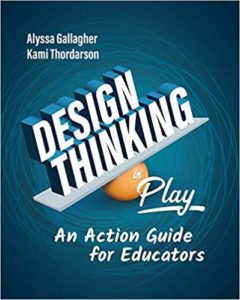An Action Guide to Design Thinking
Design Thinking in Play: An Action Guide for Educators
By Alyssa Gallagher and Kami Thordarson
(ASCD, 2020 – Learn more)

While many industries now use a design thinking model to identify and solve problems (including making new products to meet user needs), schools for the most part are still using the “best practices” approach established by Horace Mann in the 1860’s (p. 1).
In this book Gallagher and Thordarson provide a clear, concise guide to the steps of the design thinking process and focus its power on teaching and learning.

Implementing design thinking chapter by chapter
Each stage is clearly defined its own chapter (empathize, define, ideate, prototype and test). The stage is clearly defined, with tips and guidance on implemention. At the end of each chapter there are two take-away boxes, one with the “Risk factors” for that stage and one for action steps. (See “The 5 Phases of Design Thinking” summarized in Chapter 1.)
The book is laid out with an introduction; an overview (with appropriate detail) of what design thinking is and what each phase encompasses; a chapter on “becoming a design thinker” that addresses the change in mindsets and procedures that need to take place to make the shift to design thinking; and a separate chapter – with details, examples and resources for implementation – for each of the stages.
The book then rounds out with a brief conclusion (less than 1 page), and two appendices, one that provides a design thinking sprint (a shortened version of the process to be used to learn how the design thinking process works) and a substantial list of resources that can easily be tapped when implementing design thinking.
This book is well referenced, the quotes are well placed within the content and are point on. For example, when discussing defining the problem, the authors choose a quote from Charles Kettering: “A problem well stated is a problem half-solved” (p. 75). The stages are well explained, and the tips, guidance and tools given are very helpful.
A process all educators can embrace
Design thinking is an important process that focuses on empathy and the needs of the end user, rather than the agenda of the “problem solver.” This is a process educators need to embrace and use in education, both for teaching students the skills they will need in their futures, and for how we go about problem-solving issues within the system of school.
This will require a shift in mindset, and a move out of our comfort zone and into the messy, unpredictable design thinking world, if we truly want to reform education. This book is easy to read, provides good clear explanations of each step of the design thinking process, and is a handy reference guide to keep close by as you are working through the process.
I believe this is a must read for all educators, administrators, and district leadership—really anyone associated with education who expects to be an active educator going forward.
Dr. Laura Von Staden is currently a Middle School Gifted Math and Science teacher in Tampa, Florida. She serves on numerous committees in her school district, works closely with the local university, and writes curriculum. She is also a professional development consultant, and previously served as an Exceptional Student Education Specialist and as a mentor.






























